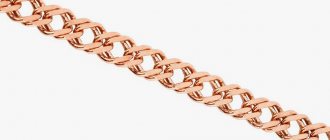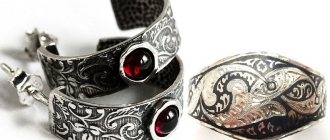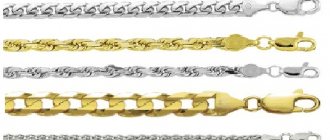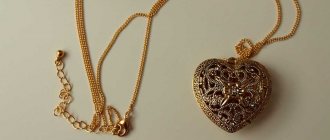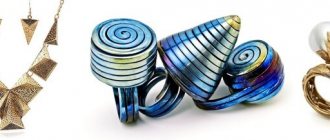Story
Jewelry craftsmen use a large number of techniques and weaves in their work: anchor, Rollo, Bismarck, armored, Cardinal and many others. Some arose back in the first millennium AD, originating from the weaving of chain mail for knights. Byzantine weaving has equally deep roots. The chain mail created using this technique was thick and reliable; in addition, it had increased strength, which was important in battle. After the adoption of Christianity, weaving also appeared in Rus'. Many years later, jewelers began to actively use this twisting in their work, creating amazingly beautiful products that were used for many years.
Interestingly, the fancy ornaments decorating the pages of books were also called because of their external similarity.
Weaving features
Byzantine weaving gives the product volume, making it more interesting and representative. At the same time, the decoration does not look pretentious or heavy. Due to its unusual complex connection, the chain or bracelet shimmers in daylight, sparkling with the edges of the links. This type of weaving is loved by middle-aged ladies and those who adhere to a classic style and dress with taste. Quite often found in jewelry stores is the Byzantium chain, which is quite thick and not intended for daily display. But she will make a festive outfit even more advantageous. The silver version is suitable for going out.
The chain is made in different materials:
- silver;
- gold;
- platinum.
Chains made with this weaving do not need additional decorations, as they are self-sufficient on their own. The product looks impressive at any length. This could be a chain, a bracelet, or a keychain option.
Byzantine weaving technology
Byzantine weaving is a unique variation of the Bismarck technique. The technology for making products using Byzantine weaving is very painstaking and difficult. As a result, jewelry is much more expensive than others made from the same material, but using a different technique, even if the weight is the same. The bizarre pattern created by the interlacing of the links gives the technique its name – “fox tail”. This technique is very well suited for the production of large, massive jewelry. The essence of weaving itself is the sequential connection of identical elements. The links can be of all shapes: round, square, oval. Jewelers often combine different materials into one piece, for example, alternating gold and silver fragments. So, a very unusual and beautiful product comes out of the artist’s hands. It takes a lot of time to make one piece of jewelry, and the more intricate and interesting the pattern, the more time it takes to create it. Not every master can afford such difficult weaving; it requires preparation and a precise hand. A chain of unequal weave of the same weight will cost differently, and a Byzantine one will be much more expensive.
To create Byzantine weaving, craftsmen use the following tools:
- Thin-nose pliers without notches, or platypuses. This tool is mandatory - it is used to connect the links of the future chain, and they should not be damaged during the work.
- Individual fragments. The shape and size of the fragments depends on the final appearance of the product and the thickness of the chain.
To make a bracelet or other jewelry of Byzantine weaving, special special conditions are required; not every jeweler can do this at home.
Specifics of the production of the Byzantine weaving chain
The “Byzantine weaving” chain is quite difficult to weave, since it is necessary to alternately connect individual links of the same size. An important point is that the links can be very different - round, oval or square. The weaving process is complex, painstaking and time-consuming, as it requires special attention to detail and to ensure that all links and their connections must be exactly the same size and located only at a given angle of inclination.
Every buyer who decides to buy a silver chain “Byzantine weaving” in our workshop should know that it is solid and representative. It looks quite brutal and voluminous, but this gives the chain a special chic, while it is almost impossible to break it - this requires considerable effort. The only thing you should remember is that the weight of the chain is quite large, and therefore the first time will be somewhat unusual.
Types of weaving
Jewelers use different methods of processing links, which allows them to create more and more original products. So, there are these types of link processing:
- Collected fox tail. It is made up of spirals twisting in different directions. The link consists of six elements, manually connected with very thin wire.
- Circle. Perhaps the most durable type. The link bundles are evenly distributed, making it impossible for the chain to break.
- Semicircular weaving. The bend radius of the elements in this case is slightly smaller.
- Square. This is what the cross section of the chain looks like. Used to create massive jewelry.
Each of these types is very durable and beautiful.
Advantages and disadvantages of weaving
Having such increased complexity in manufacturing, chains and bracelets of Byzantine weaving have a number of advantages:
- Durability of decoration.
- Appearance. The weaving looks intricate and elegant, but does not go beyond what is permissible: it attracts the attention of others, but does not shock them. The product is laconic and sophisticated.
- Byzantine weaving makes the product presentable, emphasizing the status of the owner, his excellent taste and wealth. Jewelry perfectly complements the official look and creates a solemn one.
- Quality is an integral parameter of products. The “fox tail” technique is suitable for jewelry that will be presented to relatives, loved ones, and loved ones. A product made using this technique lasts a long time and is effective. You can safely wear it without taking it off, without fear of accidentally losing it. The chain will not break accidentally, and to do this, you need to apply enormous force.
Weaving very well accepts various experiments by master jewelers - in the combination of metals, colors, shapes and sizes of links.
The disadvantages include the high price for jewelry, which is quite reasonable if you remember the advantages. The quality, appearance and complexity of production are worth it.
Byzantine weaving: basic basis and variations
Good day! Today we want to tell you about one of the most beautiful basic chainmail weaves known as Byzantine (aka Byzantine, Etruscan, Birdcage, Fool's Dilemma, Idiot's Trap, Idiot's Delight, Bird's Nest)
For work we will need the following: - thin-nosed pliers (platypus) for working with jewelry
It is fundamentally important to use thin-nose pliers without notches, otherwise the rings will deteriorate (scratch) during operation. In the photo above there are two options for thin-nose pliers: curved and straight. You can use any option. We personally use a pair of curved ones in the lead hand and straight ones in the trailing hand;
- a set of ready-made rings
in this case we take rings with an outer diameter of 5.5 mm and a wire thickness of 1 mm; - one hour time
So let's get started:
STEP 1.
We take an open ring and attach four closed rings to it.
Step 2.
We close the ring and add another one, also threading it through the four closed ones.
as a result of the first two steps we get a piece of the “2 in 2” chain
STEP 3.
Now we turn the outer rings in the opposite direction and hook the ring to them between the two middle rings.
Add another ring and get half a link in the Byzantine chain.
STEP 4.
We hook two more rings to the outer rings,
STEP 5.
and two more for them.
Then you need to repeat the third step (unfold the outer rings and place two rings between the previous ones)
As a result, we obtain a complete link in the Byzantine chain.
Next, we weave the chain following steps 4, 5, 3 to the desired length. You can use a carabiner or toggle as a clasp, your choice.
As you work, pay attention to how you close the rings - a ring that is not tightly closed can get scratched, cling to clothing and bend the weave. Try to close them “joint to joint.” Before attaching the clasp, make sure that the outer rings of the chain lie in the same plane (as in the picture after step 5); if the outer rings are rotated (as in the picture after step 3), then you should add another half of the chain link. Now you can attach the lock. Here is an example of a finished Byzantine bracelet with a carabiner
This weaving can be used both as an independent ready-made bracelet, and as a base on which you can attach beads, pendants, and anything else your creative nature desires.
But the interesting things don’t end there! You can use different sizes of rings.
On this bracelet we used rings with a diameter of 8mm and a thickness of 1.2mm. In step 1, you should hook 5 closed rings (instead of the original 4) and in step 3, thread 3 rings (instead of the original two). The result is a severe, voluminous bracelet with a very flexible weave. The same weaving is also suitable for rigid volumetric weavings.
In fact, we cannot even imagine when we will run out of options for this weaving, and we invite you to create with us, conduct creative experiments and come up with something new, interesting and beautiful!
Photos of the technical process taken from Cristian Badea's masterclass "Byzantine Chainmaille Tutorial"
In what cases and how to wear the product
Decorating yourself with such a chain will be appropriate and advantageous in the following situations:
- For a young girl going to a special event. A lighter weave, thin and delicate, will look impressive in everyday wear.
- A lady of Balzac's age can easily combine Byzantine chains with clothes in a classical style. In this case, the product will not only perform an aesthetic function, but will also become an indicator of the status and taste of the owner.
- As for the material from which the chain or other jewelry is made, a silver chain of Byzantine weaving would be very appropriate at a meeting with friends, on a date with a young man, at the theater or at a concert. If the event is of a more significant nature, gold chains will emphasize its importance. Byzantine weaving looks great at a wedding or anniversary.
For a man, a chain with a combination of metals and flowers or a gold-plated steel bracelet is suitable. In this case, steel will look no less impressive than jewelry made from precious materials. As for age, Byzantine weaving is always suitable for men, but it is still preferred by men over 35.
The thickness of the chain has a big impact on who and where it is best to wear it. Thus, more massive products will suit older men, or women at formal evenings. A thin chain will highlight your everyday look. A silver chain will fit well into your everyday look, while a gold one is more suitable for evening outings.
In Moscow, they listen to recommendations not to wear Byzantine chains with additional jewelry or decorative elements. Byzantine weaving suggests that the gold or silver chain is a decoration in itself and does not need additional support. Any additional element will make the decoration more simple and ordinary. If, nevertheless, habit or taste requires wearing additional elements, then their mass should not be greater than the mass of the chain itself. This applies to any decoration, regardless of what kind of weaving it is created with.
Who should buy the Byzantine weave chain?
It’s very easy to order a “Byzantine weaving” chain made of silver with blackening in our Workshop - you can do it in one click. This model is preferred by men over 30 years old, on whom the chain looks beautiful and logical. An interesting addition to the chain will be amulets and charms, widely represented in our assortment. Due to the fairly large mass of the chain, it is worth choosing not the smallest pendants that will look logical and dignified. Depending on the wishes of the buyer, the chain can be the optimal length for him, and the final weight depends on this.
